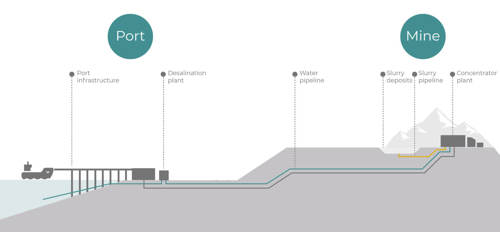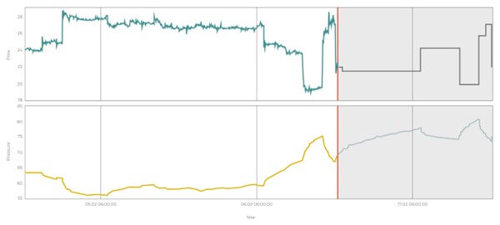From slurry to consumption: the current state of water management in Latin American mining companies
Water is vital in the Latin American mining industry’s operational processes and a substantial amount is used every day for reasons ranging from mineral processing, separation and extraction to the movement of ores across long distances in slurry pipelines. Many mines are in dry and remote locations too, so water is a crucial resource not only for operations, but for use and consumption by staff at the mining companies.
Chile’s copper mines produce approximately a quarter of the planet’s copper supply, with the majority of its production coming from one of the world’s driest places. While it’s important to ensure there is access to water in these locations, it’s also worth noting that the amount of water the Chilean mining industry consumes annually could be used to sustain 75% of the Chilean population’s needs.1
Similarly, Brazil is estimated to use 1.6% of its total water supply for mining which could sustain the entire rural population of Brazil with water. Just as water is vital to effective mining pipeline operations, it’s essential for the survival of people in residential areas too. Data from the Pastoral Land Commission indicates that 124 out of the 197 recorded conflicts about water in Brazil occurred in areas where mining ore extraction is common.2
Following pressure from external sources about their water usage, many Latin American mining pipeline operators are now looking at their water management and how they can make best use of the water resource. For example, Chilean mining pipeline companies have turned to desalination plants following the introduction of a ban on the use of fresh water in mining to preserve water supply during their drought. Many other mining companies are following suit when it comes to desalinated water too.
This article considers water management related challenges facing Latin America’s mining industry and how pipeline solutions can support mining companies’ ongoing social responsibilities.
What is desalination?
Desalination is the process of removing mineral salts (or saline) from water. With fresh water being in short supply in the Middle East, desalination is a widely used process to supply drinking water to residential areas.3 The Water Conversion Corporation (WCC), which has an extensive pipeline network including tank farms that take desalinated water from the coast to the desert, has previously used Atmos Simulation (SIM) Suite’s optimizer module to recommend its pumping schedules.4
Due to the mining industry requiring uncontaminated water, desalination is often used to support mining pipeline operations and can involve many approaches. The most common desalination process is reverse osmosis, which involves using high pressure to pass seawater over a membrane which filters out the minerals and other contaminants, creating desalinated water.5 The resource is then distributed to where it’s required. In the case of Figure 1, desalinated water is pumped through a water pipeline to be used in the mine.
Remaining desalinated water can be lost through evaporation, reused or returned to the environment.

Figure 1: An example of a mining and slurry pipeline operation which uses desalinated water extracted from the sea via reverse osmosis
Optimizing desalinated water use
Water usage in the Latin America mining industry occurs alongside widespread water shortages in residential areas, which has only been exacerbated by the COVID-19 pandemic,6 so efforts are being made to optimize water usage and reduce wastage.
As previously mentioned, Atmos SIM’s optimizer module can help plan pipeline operational requirements in advance, but simulation software can also provide look-ahead modules. For example, Atmos SIM’s nominations look-ahead avoids overruns in a pipeline operation by mapping out pressures on the pipeline based on loads and nominations.4 For a pipeline in a mining and slurry network transporting desalinated water to the concentrator plant, solutions like look-aheads and optimizers can ensure bookable capacity is never underestimated or overestimated so there is less risk of water being wasted.

Figure 2: A nominations look-ahead has the ability to forecast future operations and has a high certainty (The top trend in the grey background is the nomination and the bottom trend the corresponding pressure)
However, the ways in which Latin American pipeline companies deal with wastewater (not to be confused with wastage) is what will have the most repercussions on the surrounding population.
Optimizing mining wastewater management
After water has reached the concentrator plant for use in mining and slurry, wastewater can be either transported off site by a third party, which is usually an expensive process, or it can be deposited in a retention pond (like that which is represented in Figure 1). It’s worth noting that it can become an increasingly arduous task handling wastewater using a retention pond as sediment builds up inside the pond.
The generally accepted best approach for wastewater management in the mining industry is through wastewater treatment on site using biological, chemical and physical treatment methods. This process is typically less costly than outsourcing or using a retention pond and presents benefits for reusing the water once it’s been treated and a reduced impact on the environment by keeping the water retained within the pipeline network.7 While wastewater treatment ensures maximum utilization of water resources, it also presents risks to the social responsibilities of the Latin American mining industry.
Chemicals hazardous to human health
Many ores extracted during the mining process contain high traces of pollutants that can seep into wastewater, with arsenic being a common example, which can impact internal organs if it comes into direct contact with the human population.7 For this reason, it’s vital that water treatment in the mining and slurry industries have effective leak detection to avoid contaminants like arsenic wastewater coming into contact with surrounding ecosystems and human communities.
Leak detection solutions like Atmos Pipe were the first of their kind to provide statistical volume balance support to function as part of a wider leak detection system that can detect onset as well as existing leaks. For Latin American mining operations operating a wastewater treatment facility, there is always a risk of pollutants escaping into the environment, so leak detection solutions can provide support that reduces the impacts of leaks with a fast and reliable alarm.
Optimizing water management against external factors
Some risks are unavoidable to a mining and slurry pipeline network’s water management. In Latin America especially, many pipelines run through high consequence areas and are exposed to a range of natural and environmental threats that can affect pipeline integrity, such as landslides, riverbed scour and underground corrosion, severe flooding and volcanic eruptions.8
If we consider the impacts of a landslide on a mining and slurry pipeline operation without leak detection as an example, a leak or rupture caused by the landslide could be hard to pinpoint due to the pipeline being buried under soil and debris. Meanwhile, the leaked wastewater would have the potential to contaminate the soil and surrounding natural water sources, causing danger to human life if residential areas nearby came into direct contact with the contaminant, not to mention the financial and reputational damage caused to the mining company.
In addition to the previously mentioned Atmos Pipe, leak detection solutions like Atmos Wave Flow use volume balance and negative pressure wave methods for fast leak detection, accurate leak location, high sensitivity and with a low false alarm rate, reducing the impacts of a leak on the surrounding population in the event of external factors like environmental and natural threats outside a mining company’s control.
Metering hardware can provide added support as part of a multi-method approach to leak detection too. For example, Atmos Eclipse is an example of non-intrusive hardware that improves leak detection performance and can continue to function and collect data during periods of downtime in the event of a natural or environmental threat.
Reduce risk on your mining and slurry pipelines long into the future
While there is a clear social responsibility in the mining and slurry industries on their water usage, from how they source it to their wastewater treatment, there exist many other risks to a mining company’s pipeline operation that need to be considered.
(First featured in International Mining, March 2023)
References
2 https://www.sciencedirect.com/science/article/pii/S2214790X21001866
3 https://www.worldatlas.com/articles/countries-who-rely-on-desalination.html
4 https://www.atmosi.com/en/resources/books/the-atmos-book-of-pipeline-simulation-chapter-12/
7 https://pubs.rsc.org/en/content/articlehtml/2022/va/d2va00002d
